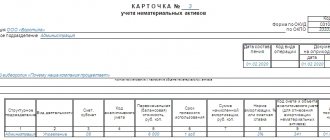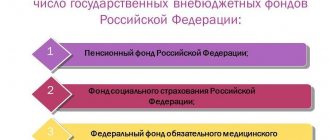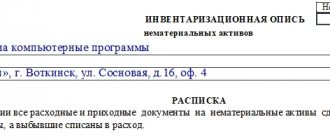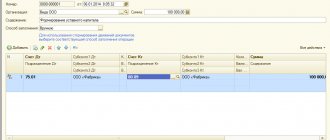Useful life
When putting it on the balance sheet, the organization must determine the useful life of the asset or decide that it is impossible to determine it (clause 25 of PBU 14/2007).
Determine the useful life of intangible assets based on:
- the period during which the organization will own exclusive rights to the object. This period is indicated in the documents of protection (patents, certificates, etc.) or it follows from the law (for example, the exclusive rights of the database manufacturer are valid for 15 years (Article 1335 of the Civil Code of the Russian Federation));
- the period during which the organization plans to use the facility in its activities;
- the quantity of products or other physical indicator of the amount of work that the organization intends to obtain using this asset.
This is stated in paragraphs 25, 26 of PBU 14/2007.
If it is impossible to determine the useful life of an intangible asset, then there is no need to charge depreciation on it (clause 23 of PBU 14/2007). Such objects are called assets with an indefinite life (clause 25 of PBU 14/2007). Factors that interfere with determining the useful life are listed in the Explanations to the Balance Sheet and the Statement of Financial Results (clause 41 of PBU 14/2007). There is also no need to charge depreciation on intangible assets of a non-profit organization (clause 24 of PBU 14/2007).
Depreciation group
Include intangible assets in the depreciation group in accordance with paragraph 3 of Article 258 of the Tax Code of the Russian Federation based on their useful life (clause 5 of Article 258 of the Tax Code of the Russian Federation). As a general rule, the useful life of intangible assets is determined based on:
- validity period of the patent or certificate;
- useful life stipulated by the terms of the contract;
- other restrictions on the terms of use of intellectual property in accordance with the laws of Russia or the applicable laws of other countries.
If it is impossible to determine the useful life based on such parameters, then set the depreciation rate for 10 years (but not more than the life of the organization).
An exception to the general rule are certain types of intangible assets, for which depreciation begins after December 31, 2010. These include:
- exclusive rights of patent holders to inventions, industrial designs, utility models and breeding achievements;
- exclusive rights of authors (other copyright holders) to use computer programs, databases, topologies of integrated circuits;
- possession of know-how, secret formulas or processes, information regarding industrial, commercial or scientific experience.
For these intangible assets, the organization has the right to set the useful life independently (regardless of the restrictions). However, the duration of this period should not be less than two years.
This procedure follows from the provisions of paragraph 2 of Article 258 of the Tax Code of the Russian Federation and paragraph 5 of Article 5 of the Law of December 28, 2010 No. 395-FZ.
Accounting
Depending on the nature of the use of the intangible asset, include the depreciation accrued on it either as part of expenses for ordinary activities, or as part of other expenses, or as part of capital investments. In this case, make the following entries:
Debit 20 (23, 25, 44...) Credit 05
– depreciation has been accrued on intangible assets used in the production of goods (performance of work, provision of services) or in trading activities;
Debit 08 Credit 05
– depreciation was accrued on intangible assets used in the creation (modernization, reconstruction) of other non-current assets;
Debit 91-2 Credit 05
– depreciation is accrued on intangible assets used in other types of activities (for example, on intangible assets provided for use by other persons).
This procedure follows from the Instructions for the chart of accounts.
It is impossible to charge amortization on the credit of account 04 “Intangible assets”, that is, reducing the initial cost of an asset from January 1, 2008. PBU 14/2007 no longer provides for this method of calculating depreciation.
Record the results of calculating depreciation charges in the primary document (Part 1, Article 9 of Law No. 402-FZ of December 6, 2011). For example, in the depreciation statement.
Calculation example
VESNA LLC acquired ownership of an intangible asset worth 5,000,000 rubles. SPI of property - 5 years. The company chose the straight-line method of accrual AM. AM calculation:
- We determine the rate of depreciation per year: 100% / number of years = 100% / 5 = 20%.
- We calculate the amount of depreciation for the year: cost × AM rate = 5,000,000 × 20% = 1,000,000 rubles.
- We determine the size of the monthly payment: annual amount AM / 12 months = 1,000,000 / 12 months = 83,333.33 rubles.
Consequently, VESNA LLC can monthly recognize AM as expenses for the purpose of calculating income tax in the amount of RUB 83,333.33.
Methods for calculating depreciation
In accounting, depreciation on intangible assets can be calculated:
- in a linear way;
- reducing balance method;
- by writing off the cost in proportion to the volume of products (works).
The organization must choose the method of calculating depreciation that will most accurately reflect the receipt of benefits from its use. If an organization cannot reliably determine the order in which benefits will flow, then use the straight-line method. Such rules are established by paragraph 28 of PBU 14/2007. Record your choice in your accounting policy.
An example of depreciation on an intangible asset. After commissioning, the use of the intangible asset is temporarily suspended
In March of this year, Alfa CJSC acquired exclusive rights to the trademark. The initial cost of exclusive rights, formed in accounting and tax accounting, is the same and amounts to 500,000 rubles. Alpha began using the trademark in April, so depreciation has been accrued on it since May. The useful life of a trademark is 5 years (60 months). Alpha calculates depreciation using the straight-line method.
The amount of monthly depreciation in accounting was: 500,000 rubles. : 60 months = 8333 rub.
In July, by agreement of the parties, the contract for the supply of products in which the trademark was used was temporarily suspended (until the beginning of next year). At the same time, the organization continues to accrue depreciation of the intangible asset (paragraph 2 of clause 31 of PBU 14/2007).
The calculation of depreciation charges for the period of useful use of the exclusive right to a trademark is presented in the table.
| Month of operation | Remaining service life, months. | Residual value of the asset at the beginning of the month, rub. | Amount of depreciation charges for the month, rub. | Residual value at the end of the month, rub. (gr. 3 – gr. 4) |
| 1 | 2 | 3 | 4 | 5 |
| May | 60 | 500 000 | 8333 | 491 667 |
| June | 59 | 491 667 | 8333 | 483 334 |
| July | 58 | 483 334 | 8333 | 475 01 |
| August | 57 | 475 001 | 8333 | 466 668 |
| September | 56 | 466 668 | 8333 | 458 335 |
Amortization of intangible assets
PBU 14/2007 provides for three methods of depreciation of intangible assets:
- linear method;
- reducing balance method;
- method of writing off cost in proportion to the volume of products (works).
Which depreciation method is better to give preference?
The choice of depreciation method for intangible assets is determined based on the calculation of expected income from the use of the asset, including proceeds from its possible sale. Thus, when developing an accounting policy for tax purposes, a company must consolidate the methodology for carrying out this calculation and establish criteria for its reliability. If an organization cannot reliably calculate future cash receipts from the use of intangible assets, then the straight-line depreciation method must be used.
The calculation of the monthly depreciation amount depends on the chosen method.
With the linear method, deductions are calculated based on the actual (initial) cost or current market value (in case of revaluation) of intangible assets evenly throughout the asset's investment period.
Example. The cost of the purchased intangible asset is 240 thousand rubles. The useful life of the useful asset is 48 months. The depreciation rate will be: 1/48 months. x 100% = 2.08%. The monthly depreciation amount is equal to: RUB 240,000. x 2.08% = 4,992 rub.
Using the reducing balance method, the monthly amount of depreciation of intangible assets is calculated using the formula:
residual on the 1st day of the month x coefficient \ remaining useful life in months.
When applying this method of depreciation, the company can set an increasing coefficient (not higher than 3), fixing it in its accounting policy for accounting purposes.
Example . The initial cost of intangible assets is 42,000 rubles. The useful life of the object is 6 months. Coefficient 2. Depreciation for 1 month of operation of the facility - 14,000 rubles. (RUB 42,000 x (2/6 months)). The residual value of intangible assets is RUB 28,000. Depreciation for 2 months - 11,200 rubles. (RUB 28,000 x (2/5 months)). The residual value of intangible assets is RUB 16,800. Depreciation for the 3rd month of operation of the asset is RUB 8,400. (RUB 16,800 x (2/4 months)). The residual value of intangible assets is RUB 8,400. Depreciation for the 4th month of operation of the facility - 5,600 rubles. (RUB 8,400 x (2/3 months). Residual value of the object—RUB 2,800. Depreciation for the 5th month of operation of the object—RUB 2,800 (RUB 2,800 x (2/2 months)). After 5 months operation of intangible assets will be fully depreciated.
With the reducing balance method, the monthly depreciation amount is determined based on the residual value of the intangible asset at the beginning of the month, multiplied by a fraction, the numerator is a coefficient (not higher than 3), and the denominator is the remaining useful life in months.
Example. The initial cost of intangible assets is 120,000 rubles. It is expected that 1,000 units of products will be produced based on it. In fact, 10 units were produced per month. Therefore, the amount of depreciation this month will be calculated as follows: 120,000 rubles. x 10 pcs. : 1,000 pcs. = 1,200 rub.
Please note that goodwill arising in connection with the acquisition of an enterprise as a property complex (in whole or part thereof) can only be depreciated using the straight-line method over 20 years.
The company must review how depreciation is determined annually. If necessary, it must be clarified. If the calculation of expected income has changed significantly, then the method needs to be adjusted. Accrued depreciation amounts are included monthly in expenses for ordinary activities. Depreciation charges for intangible assets begin on the first day of the month following the month in which this asset was accepted for accounting, and are accrued until the cost is fully repaid or the asset is written off from accounting.
Depreciation charges are recognized as expenses for ordinary activities of the reporting period to which they relate. These amounts are reflected in the debit of cost accounting accounts (20, 25, 26, 44) and the credit of account 05 “Depreciation of intangible assets”. Tax accounting provides only two methods for depreciating intangible assets:
- linear method;
- nonlinear method.
The company must also record the chosen depreciation method in its accounting policies. In this case, the chosen method must be applied to all intangible assets, except for objects included in the eighth-tenth depreciation group. The linear method is always applied to such intangible assets.
The company has the right to change the depreciation method for intangible assets that are included in the first seventh depreciation group from the beginning of the year. At the same time, it is possible to switch from a nonlinear to a linear method only five years after the start of its use.
In tax accounting, depreciation amounts must be reflected in expenses associated with production and (or) sales (clause 3, clause 2, article 253 of the Tax Code of the Russian Federation).
An example of reflection in the accounting of intangible assets. The company decided to develop a website, concluding an agreement for its creation with a specialized organization. The amount of expenses under the contract amounted to 120,000 rubles. (including VAT RUB 12,000). She accepted it for registration as an intangible asset. Useful life 36 months. The method of calculating depreciation according to the company's accounting policy is linear. The actual (initial) cost of intangible assets is 108,000 rubles. (120,000 12,000). With the linear method of calculating depreciation, the monthly amount of deductions is determined evenly over the established time limit based on the initial cost of the intangible asset. In this case, the monthly depreciation amount for the site is 3,000 rubles. (RUB 108,000 36 months). Depreciation on intangible assets is accrued from the 1st day of the month following the month in which this object was accepted for accounting until its cost is fully repaid or this asset is written off from accounting. During the SPI, the accrual of depreciation charges on intangible assets is not suspended.
The company must make the following entries in accounting: 1. Debit 08 Credit 60,108,000 rub. (the costs of creating the website are reflected); 2. Debit 19 Credit 60 12,000 rub. (VAT presented by the contractor is taken into account); 3. Debit 68 Credit 19 12,000 rub. (VAT accepted for deduction); 4. Debit 04 Credit 08,108,000 rub. (the site is accepted as an intangible asset); 5. Debit 60 Credit 51,108,000 rub. (developer invoice paid); 6. Debit 44 Credit 05 3,000 rub. (the amount of depreciation is reflected).
Linear method
To calculate depreciation using the straight-line method, you need to know the original cost of the intangible asset (current market value if the asset is revalued) and its useful life. The organization is obliged to use this method to amortize business reputation (clause 44 of PBU 14/2007).
Determine the depreciation amount for the month using the formula:
| Depreciation amount per month | = | Initial (current market) value of an intangible asset | : | Useful life of an intangible asset (months) |
This procedure is provided for in subparagraph “a” of paragraph 29 of PBU 14/2007.
The linear method of calculating depreciation is also used in tax accounting. For details on the specifics of its use, see How to calculate depreciation of intangible assets using the straight-line method in tax accounting.
The advantage of the straight-line method of calculating depreciation is its ease of application: the cost of an intangible asset is repaid evenly over its entire useful life. Therefore, it is used in cases where it is difficult to predict future revenues from the use of an asset (clause 28 of PBU 14/2007). In addition, using the linear method in accounting and tax accounting will allow you to avoid temporary differences.
An example of calculating depreciation for intangible assets using the straight-line method
Alpha LLC acquired exclusive rights to the trademark. The organization cannot predict the volume of production and sales of products in which this trademark will be used. Therefore, it was decided to depreciate the object using the straight-line method in both accounting and tax accounting. The initial cost of exclusive rights, formed in accounting and tax accounting, is the same and amounts to 500,000 rubles.
The useful life of exclusive rights to a trademark in accounting and tax accounting is 11 years (132 months).
The amount of monthly depreciation in both accounting and tax accounting was: 500,000 rubles. : 132 months = 3788 rub.
Reducing balance method
To calculate depreciation of a declining balance using this method, you need to know the residual value of an intangible asset at the beginning of the year, its useful life and the coefficient established by the organization, but not more than 3. Such rules are provided for in subparagraph “b” of paragraph 29 of PBU 14/2007.
Situation: is it possible to set different coefficients for different intangible assets when calculating depreciation using the reducing balance method in accounting?
Answer: yes, you can.
PBU 14/2007 does not establish any restrictions on the choice of coefficient when calculating depreciation, except that its value cannot exceed 3 (subclause “b”, clause 29 of PBU 14/2007). Therefore, an organization can choose it independently for each object; this point of view is also confirmed by the fact that the organization must choose a depreciation method for each asset unit, which reflects the receipt of future economic benefits (clause 28 of PBU 14/2007).
Calculate the amount of monthly depreciation using the formula:
| Depreciation amount per month | = | Residual value of the intangible asset at the beginning of the month | × | Coefficient _________________________________ |
| Remaining useful life in months |
This procedure is established by subparagraph “b” of paragraph 29 of PBU 14/2007.
Since the residual value of the intangible asset is taken at the beginning of each month, the annual depreciation amount will gradually decrease.
An example of calculating depreciation on intangible assets using the reducing balance method
Alpha LLC acquired the exclusive right to the trademark. The initial cost of exclusive rights, formed in accounting, is 200,000 rubles. Its useful life is 10 years, or 120 months (10 years × 12 months). The coefficient that most accurately reflects the income from the use of this asset is 2.
Alpha began using the trademark in February. Therefore, depreciation on it is calculated from March. The calculation of depreciation charges for the period of useful use of the exclusive right to a trademark is presented in the table.
| Month of operation | Remaining service life | Residual value of the asset at the beginning of the month | Amount of depreciation charges for the month, rub. (gr. 3 × 2 : gr. 2) | Residual value at the end of the month, rub. (gr. 3 – gr. 4) |
| 1 | 2 | 3 | 4 | 5 |
| March | 120 | 200 000 | 3333 | 196 667 |
| April | 119 | 196 667 | 3305 | 193 362 |
| May | 118 | 193 362 | 3277 | 190 085 |
| … | … | … | … | … |
The declining balance method is most appropriate for those assets whose benefits accrue in a larger amount at the beginning of its use. The fact is that the maximum amount of depreciation when using this method is accrued in the first months.
The non-linear depreciation method used in tax accounting has some similarities with the declining balance method, in which depreciation is calculated based on the residual value and the depreciation amount decreases monthly. However, these methods are not complete analogues. The main differences between the nonlinear method (tax accounting) and the reducing balance method (accounting) are as follows:
- with the non-linear method, depreciation is calculated based on the total cost of all depreciable property items belonging to a given depreciation group (clause 2 of article 259.2 of the Tax Code of the Russian Federation);
- after the total balance of the depreciation group becomes less than 20,000 rubles, in tax accounting the organization has the right to take into account the entire residual value of the total balance as part of non-operating expenses of the current period (clause 12 of article 259.2 of the Tax Code of the Russian Federation);
- with the non-linear method, a fixed depreciation rate is established for each depreciation group, which does not depend on the useful life of the depreciable property included in this depreciation group (clause 5 of Article 259.2 of the Tax Code of the Russian Federation).
Such conclusions can be drawn based on a comparison of subparagraph “b” of paragraph 29 of PBU 14/2007 and Article 259.2 of the Tax Code of the Russian Federation.
Calculation methods in tax accounting
For business profit tax purposes, one of two ways to determine depreciation is used:
- linear approach;
- non-linear approach.
If the regulated service life of an intangible asset exceeds 20 years, only a linear approach to calculating depreciation should be used.
For other assets in this category, the rights-holder organization may choose between linear and non-linear approaches.
Tax legislation provides for the possibility of an enterprise switching from a non-linear approach to a linear method of depreciation of intangible assets, but this is allowed to be done a maximum of once every five years.
For intangible assets, depreciation begins on the first day of the month following the month the asset was put into operation.
The linear approach to depreciation of intangible assets in the tax accounting system is similar to how it is done in accounting. The calculation method and conditional example were discussed above.
The nonlinear approach involves calculating monthly depreciation for each of the existing depreciation groups using the following formula:
Formula:
AOmg = (Bg * NAg) / 100,
AOmg – depreciation charges for the billing month for a specific depreciation group of intangible assets.
Bg – the total book value of a specific depreciation group of intangible assets.
NAg is the monthly depreciation rate for a specific group of intangible assets (established by the norms of the Tax Code).
Example for nonlinear
Initial data:
For example, on June 1, 2019, an enterprise purchased an intangible asset for 100,000 rubles. These expenses are reflected in accounting. The asset has been put into operation since 09/01/2019.
The validity period of the registered patent is from 06/01/2019 to 05/31/2029, that is, 10 years, or 120 months.
Thus, the regulated service life is 120 months.
The intangible asset belongs to the fifth (V) depreciation group.
This is the only asset in this group. For this IMA, the NAg indicator is 2.7%.
Calculation:
Depreciation of this intangible asset has been calculated by the accountant since October 2019 in the following order:
| Month | Bg (in rubles) at the beginning of the month | AOMG (in rubles) |
| 09.2019 | 0 | 0 |
| 10.2019 | 100000 | 100000 * 2,7% = 2700 |
| 11.2019 | 97300 (100000 – 2700) | 97300 * 2,7% = 2627 |
| 12.2019 | 94673 (97300 – 2627) | 94673 * 2,7% = 2556 |
| 01.2020 | 92117 (94673 – 2556) | 92117 * 2,7% = 2487 |
For the remaining months of the regulated service life, the calculation of AOmg is carried out in a similar way.







